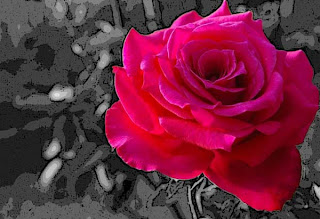More Photoshop...
I hope that by now you have a good taste of what Photoshop is all about, and are hopefully enjoying creating some cool digital art. READ THE ENTRY BELOW, if you haven't done so yet. You should copy the Keyboard Shortcuts in your Photoshop Notes and the definitions mentioned there (what is Photoshop, what are bitmaps, what are layers, what is a JPEG, etc.)
This Second Quarter we will concentrate on this image-editing application and create many Photoshop exercises. The goal is to become proficient and learn the basics. You must become very familiar with the Photoshop Toolbox and repeat some of the exercises (as many times as you want - the more the better!), so that you don't forget how to do certain things in Photoshop right away.
By now, you should know how to use the Magnetic Lasso Tool, the History Brush Tool, the Eraser Tool, and the Move Tool very well. You should know how to create layers of images and how to duplicate layers. Also, how to "unlock" the Background layer (so that you can edit this layer). You should know how to use the Hue/Saturation window, the Free-Transform command and how to "desaturate" an image or picture (what is "desaturate"? - you should know this).
If you have any questions concerning what we have learned so far, please ask Mrs. Feld.
You must have completed at least 6 exercises (I'm hoping!). The first one was the one where we selected a flower with the Magnetic Lasso Tool, created a layer of the flower and desaturated the background - also adding a filter to it. I should find this exercise in the Server, as well as the 4 exercises assigned during the Kairos Week (if you haven't completed these, please do so ASAP). These exercises can be found in iLife06 in the ASSIGNMENTS folder.
The other exercises for the Second Quarter (Exercises 1 - 12) can be found in the PHOTOSHOP folder in iLife06. Take your time doing them, read the instructions carefully and ask questions if you have them! I have to write instructions for Exercises No. 10-12 (the Adobe Website mentioned in this document was changed).
Today we worked on the "Fall Leaf" Exercise. I should also find this one in the Server (under your class in the Public Folder). You should have a Photoshop or a Second Quarter folder there. Repeat this exercise, or a similar one to learn the techniques learned. Before Thanksgiving you will have a Quiz, reviewing a similar exercise and covering the Photoshop Notes (Tuesday, November 24th).
We will also cover a few textbook exercises that will help you understand better the many options, techniques, filters and tools that can be used when using this application to edit and improve pictures and to create new digital art.
This Second Quarter we will concentrate on this image-editing application and create many Photoshop exercises. The goal is to become proficient and learn the basics. You must become very familiar with the Photoshop Toolbox and repeat some of the exercises (as many times as you want - the more the better!), so that you don't forget how to do certain things in Photoshop right away.
By now, you should know how to use the Magnetic Lasso Tool, the History Brush Tool, the Eraser Tool, and the Move Tool very well. You should know how to create layers of images and how to duplicate layers. Also, how to "unlock" the Background layer (so that you can edit this layer). You should know how to use the Hue/Saturation window, the Free-Transform command and how to "desaturate" an image or picture (what is "desaturate"? - you should know this).
If you have any questions concerning what we have learned so far, please ask Mrs. Feld.
You must have completed at least 6 exercises (I'm hoping!). The first one was the one where we selected a flower with the Magnetic Lasso Tool, created a layer of the flower and desaturated the background - also adding a filter to it. I should find this exercise in the Server, as well as the 4 exercises assigned during the Kairos Week (if you haven't completed these, please do so ASAP). These exercises can be found in iLife06 in the ASSIGNMENTS folder.
The other exercises for the Second Quarter (Exercises 1 - 12) can be found in the PHOTOSHOP folder in iLife06. Take your time doing them, read the instructions carefully and ask questions if you have them! I have to write instructions for Exercises No. 10-12 (the Adobe Website mentioned in this document was changed).
Today we worked on the "Fall Leaf" Exercise. I should also find this one in the Server (under your class in the Public Folder). You should have a Photoshop or a Second Quarter folder there. Repeat this exercise, or a similar one to learn the techniques learned. Before Thanksgiving you will have a Quiz, reviewing a similar exercise and covering the Photoshop Notes (Tuesday, November 24th).
We will also cover a few textbook exercises that will help you understand better the many options, techniques, filters and tools that can be used when using this application to edit and improve pictures and to create new digital art.

